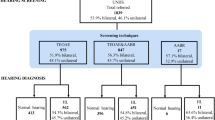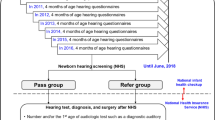Abstract
With the identification of hearing loss at birth and appropriate intervention within 6 months after birth, language can develop normally, even in children with severe hearing impairment. Universal newborn hearing screening (UNHS) is now endorsed by numerous national groups, including the American Academy of Pediatrics. Two electrophysiologic techniques — automated auditory brainstem response (ABR) and otoacoustic emissions (OAEs) — are used for the identification of communicatively significant hearing loss in newborn infants. UNHS is legislatively supported by more than one half of the United States, including the most populous. Successful hearing screening and intervention programs require the support and expertise of pediatricians, including perinatologists.
This is a preview of subscription content, access via your institution
Access options
Subscribe to this journal
Receive 12 print issues and online access
$259.00 per year
only $21.58 per issue
Buy this article
- Purchase on Springer Link
- Instant access to full article PDF
Prices may be subject to local taxes which are calculated during checkout
Similar content being viewed by others
Author information
Authors and Affiliations
Rights and permissions
About this article
Cite this article
Hall III PhD, J. Screening for and Assessment of Infant Hearing Impairment. J Perinatol 20 (Suppl 1), S113–S121 (2000). https://doi.org/10.1038/sj.jp.7200436
Published:
Issue Date:
DOI: https://doi.org/10.1038/sj.jp.7200436



